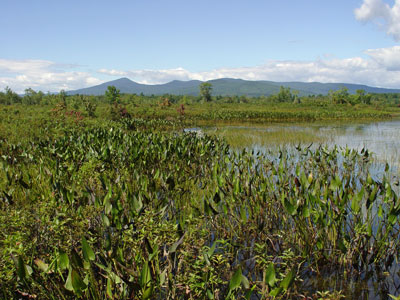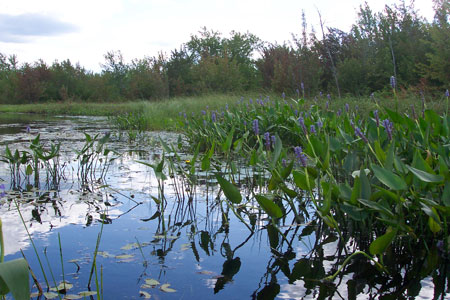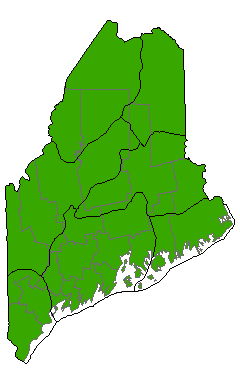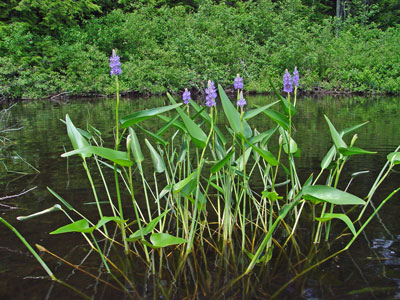DACF Home → Bureaus & Programs → Maine Natural Areas Program → Communities, Plants, and Animals → Natural Community Fact Sheets → Pickerelweed Marsh
Printer Friendly Fact Sheet - 1 MB pdf (Get a free copy of Adobe Acrobat Reader)
Pickerelweed Marsh
Scientific Name: Pickerelweed - Macrophyte Aquatic Bed; State Rank: S5

- Community Description
- Soil and Site Characteristics
- Diagnostics
- Similar Types
- Conservation, Wildlife and Management Considerations
- Distribution
- Characteristic Plants
- Associated Rare Plants
- Associated Rare Animals
- Examples on Conservation Lands You Can Visit
Community Description: This shallow water aquatic type is dominated by a mixture of emergent plants, floating plants, and submerged plants suspended in the water column. Pickerelweed, yellow water-lily, and bladderworts are almost always present, and one or more is typically dominant. A variety of pondweed species, bulrushes, bur-reed species, and other aquatics may be present. Total cover ranges from 30-100% and is typically >50%. Back to top.
Soil and Site Characteristics: This community occupies quiet waters along the shores of lakes, ponds, and streams. The substrate is usually mucky, and the water is generally <0.7 m deep. Waters are acidic to circumneutral. Back to top.

Diagnostics: This type is characterized by emergent aquatic vegetation with pickerelweed and/or yellow water-lily prominent. Water bulrush and Oakes’ pondweed are also indicator species. Back to top.
Similar Types: Open-water Marsh vegetation shares many species but is dominated by floating or submerged plants, not emergent plants. Both types have water-lily species, but they are less abundant in the pickerelweed type than in the water-lily type. The Sandy Lake - Bottom community has more of its vegetation on the bottom surface and fewer floating leaved plants. Cattail Marshes may be adjacent but feature cattails and shrubs rather than plants that die back below the surface at the end of the growing season. Back to top.
Conservation, Wildlife and Management Considerations: This aquatic vegetation type is widespread and abundant in Maine. It can be found in the quieter portions of streams and rivers as well as in lakes and ponds. It provides habitat for a variety of water dependent animals. Many examples occur on public lands and private conservation lands; however, this common type is often not documented. The major threats to this community are water quality degradation from excess nutrients in runoff and the spread of invasive aquatic plants such as Eurasian water-milfoil and variable water-milfoil.
In southern and central parts of the state, this community type hosts a number of common reptiles such as northern water snakes, common snapping turtles, and eastern painted turtles. Bullfrogs and green frogs inhabit this community statewide, and mink frogs may be found in occurrences from central Maine northward. Northern leopard frogs may utilize these wetlands as breeding grounds. These productive wetlands provide foraging habitat for a number of waterfowl including rare species such as the common moorhen and American coot. Dragonfly and damselfly diversity is typically high in these wetlands. Back to top.
Distribution: Statewide, extending into lower New England and Canada. Landscape Pattern: Small Patch. Back to top.


Characteristic Plants: These plants are frequently found in this community type. Those with an asterisk are often diagnostic of this community.
- Herb
- Pickerelweed*
- Pipewort
- Spotted bladderwort*
- Water bulrush*
- White water-lily*
- Yellow water-lily*
There are no documented rare plants associated with this natural community.
- American coot
- Black-crowned night heron
- Common moorhen
- Least bittern
- Spatterdock darner
Examples on Conservation Lands You Can Visit
| Example | County |
|---|---|
| Merrymeeting Bay Wildlife Management Area | Sagadahoc Co. |
| Range Ponds State Park | Androscoggin Co. |
| Sebago Lake State Park | Cumberland Co. |
